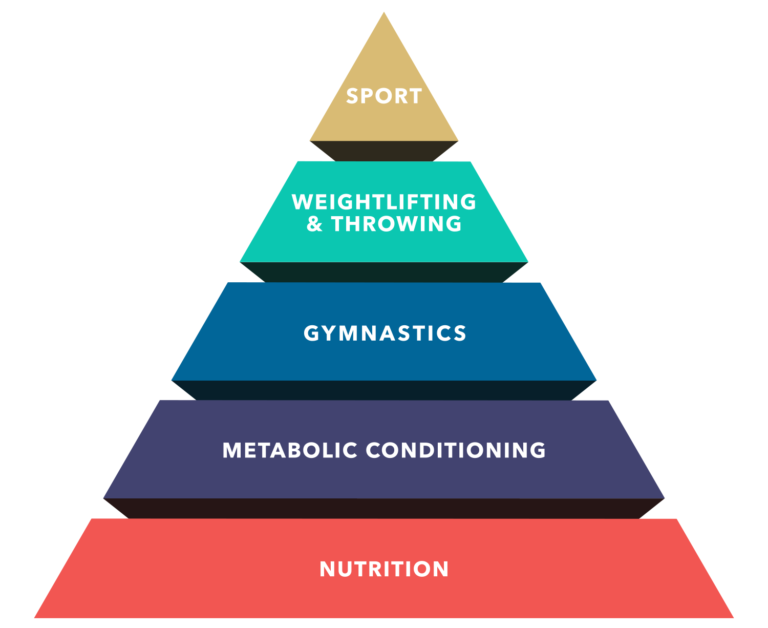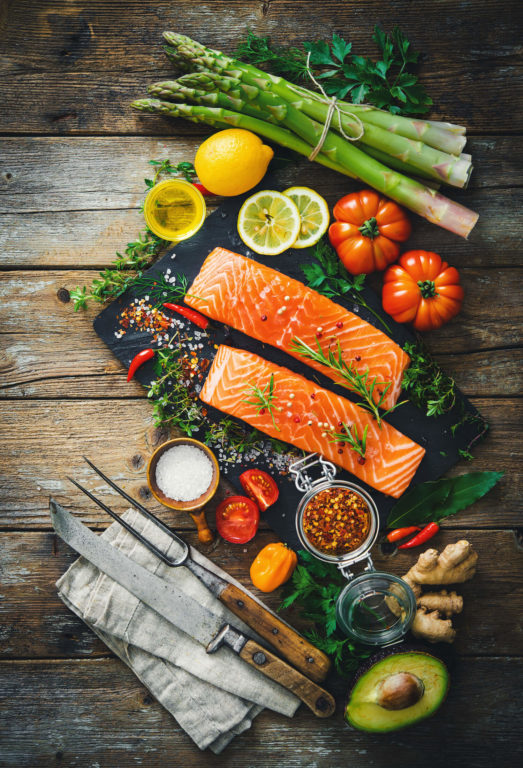 CrossFit’s Theoretical Hierarchy of the Development of an Athlete was first introduced in “What Is Fitness?” in 2002. This hierarchy underscores the foundational role of nutrition in enhancing health and performance. Sound nutrition is the foundation of health and performance because the food we consume acts as the vital fuel for all our activities. Unhealthy eating habits invariably lead to suboptimal performance and well-being. Conversely, making the right dietary choices in appropriate proportions can profoundly improve both our physical state and performance levels.
CrossFit’s Theoretical Hierarchy of the Development of an Athlete was first introduced in “What Is Fitness?” in 2002. This hierarchy underscores the foundational role of nutrition in enhancing health and performance. Sound nutrition is the foundation of health and performance because the food we consume acts as the vital fuel for all our activities. Unhealthy eating habits invariably lead to suboptimal performance and well-being. Conversely, making the right dietary choices in appropriate proportions can profoundly improve both our physical state and performance levels.
A prevalent misconception is that overhauling your nutrition must occur all at once, which can be mentally overwhelming and deter behavior change. In reality, these changes can be accomplished incrementally. Even a simple shift in breakfast choices — opting for eggs, fruit, and avocado over cereal — yields tangible health and performance improvements. These ongoing, gradual adjustments have a cumulative, transformative impact on your overall quality of life.
CrossFit’s Nutrition Prescription
CrossFit simplifies the concept of nutrition. Our recommendation is straightforward: Prioritize the consumption of meats, vegetables, nuts and seeds, some fruit, little starch, and no added sugar. To optimize your health and performance, keep intake to levels that support exercise and not body fat. Essentially, it boils down to adopting a diet rich in whole, unprocessed foods while minimizing sugar as much as possible.
Achieving this recommendation might appear uncomplicated in theory but can be challenging to implement, especially with an abrupt shift. For optimal outcomes, establish manageable habits that can be swiftly integrated, sustained, and compounded over time.
Quality Foods
The foundation of a healthy diet revolves around the transformation of dietary choices, shifting away from processed foods, and embracing whole, unadulterated alternatives. This forms the initial pillar of CrossFit’s dietary guidelines. To embark on this journey, it’s crucial to grasp the concept of processed foods and their exceptions. We champion the consumption of unprocessed or minimally processed foods, recognizing that certain food preparation methods — like cooking, chopping, heating, blending, preserving, or fermenting — are entirely acceptable.
For a clearer understanding of processed foods, it’s helpful to distinguish what they are not. High-quality food comprises unprocessed or minimally processed options that:
- Do not compromise our insulin response.
- Retain their nutrient value without degradation.
- Exclude extraneous ingredients like sugars, industrial seed oils, preservatives, artificial colorings, or other additives.
 Whole, natural foods can be categorized based on their predominant macronutrient content, even though they often contain a blend of macronutrients. Proteins, fats, and carbohydrates constitute these macronutrients, each playing vital roles in physiological processes such as energy generation, hormone synthesis, micronutrient absorption, and cellular growth, maintenance, and repair. The primary macronutrient composition of our recommended foods is outlined below.
Whole, natural foods can be categorized based on their predominant macronutrient content, even though they often contain a blend of macronutrients. Proteins, fats, and carbohydrates constitute these macronutrients, each playing vital roles in physiological processes such as energy generation, hormone synthesis, micronutrient absorption, and cellular growth, maintenance, and repair. The primary macronutrient composition of our recommended foods is outlined below.
Meat encompasses a wide range of protein sources, including animal proteins like beef, poultry, pork, and seafood, as well as alternatives such as tofu, tempeh, legumes, and eggs. Besides meeting your protein needs, these options deliver a rich array of essential vitamins and minerals. Notably, many animal proteins come with varying fat content, whereas non-animal sources may introduce carbohydrates into your diet. This diversity should be considered when planning your meals.
Vegetables denote an array of plants like leafy greens, carrots, peppers, and more. While they fall under the carbohydrate category, their digestible carb content is relatively low. Instead, vegetables shine as excellent sources of fiber, essential vitamins, minerals, and occasionally protein.
Nuts and seeds serve as the primary source of healthy fats. This category includes almonds, walnuts, coconuts, avocados, and oils like olive oil and avocado oil. These fats bring forth a range of vital nutrients. Though nuts and seeds do contain some protein and carbohydrates, their main contribution lies in the substantial healthy fats they offer. Please note that vegetable oils are not included due to their potential adverse effects on health.
Some fruit means fruits with moderate carbohydrate content, such as apples, berries, bananas, and melons. Beyond sugars like glucose and fructose, fruits bring fiber, vitamins, minerals, and even a modest protein content. The term “some” underscores the importance of moderating your carbohydrate intake.
Little starch addresses carbohydrate sources with high digestibility, typically found in grains like wheat, rice, and potatoes, as well as legumes. These foods contain moderate levels of vitamins, minerals, and a limited protein content, all at lower densities compared to other categories. The word “little” emphasizes the need for moderation in your carbohydrate consumption.
No sugar unequivocally excludes all forms of added sugars, including natural sweeteners like honey or maple syrup and artificial sweeteners like sucralose. Whole foods contain naturally occurring sugars and so it’s important to note that this guideline refers to added sugars. This strict parameter promotes optimal gut health and hormonal balance.
Why No Sugar?
Excess sugar consumption has been linked to conditions such as insulin resistance, hyperinsulinemia, and a host of chronic diseases such as cardiovascular disease and Type 2 diabetes. Sugar comes in the form of many names in order to hide the ingredient in the ingredient list. Examples include agave nectar, barley malt, evaporated cane juice, carob syrup, corn syrup solids, dextrin, fruit-juice concentrate, maltodextrin, rice syrup, and sweet sorghum, to name a few.
A lot of processed foods are now replacing sugar with artificial sweeteners, which seems, on the surface, like a good idea to reduce the risk of metabolic disease. This may seem like a good strategy, but most of these foods still include industrialized seed oils, and recent research indicates non-caloric sweeteners may impact our metabolism — directly or indirectly. Sucralose and acesulfame potassium can raise insulin levels directly, while sweeteners like aspartame may negatively alter gut bacteria, potentially increasing insulin resistance. Artificial sweeteners, being highly processed chemicals, don’t align with a whole, unprocessed food diet.
Even “natural” sweeteners like stevia have their drawbacks. Emerging research links stevia to potential disruptions in gut health, possibly leading to issues such as irritable bowel syndrome, which is associated with metabolic disorders like obesity and Type 2 diabetes.
What is an industrialized seed oil?
When prioritizing wellness through dietary choices, it’s crucial to steer clear of not only added sugars but also industrialized seed oils. Typically found as additives in processed foods, these oils include canola, corn, cottonseed, soy, sunflower, safflower, and grapeseed oils. Despite their reputation as heart-healthy options, industrialized seed oils come with notable health concerns. They are high in omega-6 fatty acids, which can disrupt the omega-6 to omega-3 balance in the body. While both fats play vital roles in human health, an imbalanced ratio can promote excessive inflammation. Because these oils are so prevalent in our food supply, an imbalance occurs and chronic inflammation ensues.
Simply, omega-6 fatty acids tend to be pro-inflammatory, while omega-3 fatty acids are anti-inflammatory. Some inflammation is essential for normal bodily functions, such as recovery from exercise or illness. However, chronic inflammation, characterized by sustained, low-level inflammation, can be detrimental. It can overstimulate the immune system, leading to attacks on healthy tissues and organs. Chronic inflammation is linked to serious conditions like cardiovascular disease, cancer, Type 2 diabetes, arthritis, and digestive disorders.
Healthy alternatives to these industrialized seed oils are healthier oils such as olive oil, coconut oil, avocado oil, or fats such as butter and lard. At first glance, the words “fats,” “butter,” and “lard” may create a sense of panic. For years, we have been told these saturated fats have a detrimental effect on our heart health. This theory has been debunked over and over again, but the misconception has remained common in the mainstream. The real risk with saturated fats is when they are eaten in conjunction with high amounts of sugar, a combination common in processed foods.
Measuring Intake
The second facet of the CrossFit nutrition recommendation revolves around precise portion control. CrossFit recommends maintaining intake at levels that support exercise and not body fat, and emphasizes the importance of measuring our food intake to meet the energy requirements of our daily lives, workouts, and recovery. Consuming more can lead to unwanted fat storage, while significantly less can result in health issues like nutritional deficiencies, muscle loss, slowed metabolism, fatigue, hormonal imbalances, weakened immunity, cognitive impairments, reduced bone density, and long-term sustainability concerns.
There are myriad options when it comes to measuring food intake, and it’s important to find what works best for you. Many in the CrossFit community utilize a block-based system known as the Zone Diet, featuring a 40% carbohydrate, 30% protein, and 30% fat ratio. Athletes determine their starting point through a straightforward calculation and adjust over time to align with their health and performance objectives.
As technology has advanced, smartphone apps have gained popularity, enabling a macro-counting approach, known as Macros. In this method, athletes establish a baseline, typically following the 40% carb, 30% protein, and 30% fat guideline. Instead of tracking blocks as one does on the Zone Diet, athletes monitor gram intake to meet their specific macronutrient targets, allowing for personalized adjustments as they progress.

Quantity of food will depend on each individual’s lifestyle, phase of life, and activity levels. When quantifying food intake, CrossFit recommends eating three to five meals within a 12-hour window. That means if you wake up at 6 a.m. and start eating at 7 a.m., you would consume all your food before 7 p.m. that same day.
This approach reduces the body’s need to burn sugar as fuel, leading to improved insulin sensitivity and reduced risk of insulin resistance. Limiting your eating time to a 12-hour window also ensures a steady caloric intake throughout the day, which plays a crucial role in maintaining consistent energy levels. Additionally, it aids in increasing satiety and minimizing cravings, preventing the pitfalls of both undereating and overeating. Finally, this method provides an accessible and sustainable starting point. It allows you to fine-tune your dietary choices over time, learning what works best for you and making necessary adjustments to align with your individual needs and goals.
The CrossFit Nutrition I online course offers a streamlined method for determining your macronutrient requirements.
The Role of Processed and Refined Carbohydrates in the Development of Chronic Disease
The realm of dietary choices can often be a maze of conflicting information. High-carb, low-carb, vegan, or carnivore — each diet claims its unique benefits. However, despite the range of advice out there, a common thread that unites all healthy eating patterns is the recommendation to avoid processed foods. Processed foods, largely characterized by their high sugar content and unhealthy fats, pose a substantial risk to metabolic health.
While processed foods encompass both processed carbohydrates and fats, they are often categorized as carbohydrates due to their prevalence in the form of high-sugar indulgences like donuts, potato chips, fries, pizza, cookies, cake, and soda. It’s a candid observation that one rarely witnesses someone indulging in purely processed fats, whereas the daily consumption of sugary treats like Skittles is not uncommon. These foods offer little to no nutritional value. Notably, they lack the essential protein required for muscle development, repair, and maintenance while also impacting blood-sugar regulation, bone health, hormone production, immune function, and tissue repair. Furthermore, they contribute to chronic inflammation, elevating the risk of conditions like Type 2 diabetes and cardiovascular disease.
These calorie-dense yet nutrient-scarce options epitomize the notion of “empty calories,” providing little nutritional return for the energy consumed. What’s truly intriguing — and concerning — about processed foods is their engineered appeal, designed to trigger overconsumption. This palatability trap makes moderation nearly impossible, adding to the challenges of combating obesity.
Making Small Changes
Lasting behavior change often doesn’t hinge on the all-or-nothing approach. While it may work for a select few, most of us benefit from making gradual adjustments that accumulate over time. The effectiveness of a new habit is closely tied to its sustainability. Creating small changes can increase motivation and the ability to develop new behaviors. Over time, these changes add up and help establish a system that supports the gradual and continuous addition of changes. Therefore, the goal is to introduce incremental changes to your diet, allowing them to compound and providing opportunities to acknowledge your successes, thus boosting your self-confidence.

This approach applies regardless of which aspect of the recommendation you are implementing. For instance, instead of attempting to eliminate processed foods from every meal and snack all at once, you can start by focusing on breakfast. Swap out cereals, toast, muffins, or scones for a breakfast featuring eggs, bacon, fruit, and a side of spinach. After you’ve gained confidence in mastering this new behavior, progress to incorporating it into your snack or lunch routine. Follow this step-by-step approach until every meal consists of whole, natural foods.
The same can be said for measuring intake — start small. Establishing your macronutrient ratios and daily intake can be simplified by determining a baseline. You don’t need to meticulously weigh and measure every meal daily. Instead, begin with precision for one meal, like breakfast or a snack, carefully measuring carbohydrates, proteins, and fats. Dedicate a few days to this focused approach before extending it to other meals. Gradually, your entire day will become quantified. With this foundation in place, make gradual tweaks to your ratios and overall intake to align with your health and performance goals.
Healthy and Easy Recipe Ideas
A frequent obstacle to adopting a healthy eating regimen is the perceived inconvenience of cooking. Opting for processed, pre-cooked, or fast-food options can be tempting due to their convenience and affordability. However, preparing meals at home need not be a cumbersome or costly endeavor. There are practical strategies that can simplify the process while staying within your budget.
One effective approach is to buy items in bulk and freeze them, which not only saves you time but also reduces expenses. Additionally, consider preparing larger batches of each meal, allowing you to enjoy them multiple times throughout the week, minimizing the time spent cooking.
For inspiration, here are some straightforward and delicious recipes suitable for breakfast, lunch, and dinner.
Breakfast:
Egg Cups
(Makes 12 cups)
Ingredients
3-4 c. shredded potato (russet, Yukon Gold, or sweet potato)
Olive or avocado oil
1 tsp. sea salt
½ tsp. pepper
¼ tsp. onion powder
10 eggs
1 oz. ham, diced
Splash of hot sauce
Instructions
- Preheat the oven to 375 F.
- Wash and shred the potatoes.
- Place the shredded potatoes on a dish or paper towel, and pat dry.
- Add the shredded potatoes to a bowl along with ½ tsp. sea salt, ¼ tsp. pepper, and onion powder.
- Spray the muffin tin with avocado or olive oil.
- Line the bottom of each muffin tin with the shredded potatoes, and press the potatoes down firmly. Bake the potatoes for 12-15 minutes or until they start to brown.
- While the potatoes are baking, whisk the eggs in a bowl, then fold in the diced ham, ½ tsp. salt, ¼ tsp. pepper and a splash or two of hot sauce.
- Remove the potatoes from the oven and pour the egg mixture into each cup.
- Bake the egg cups for an additional 12-15 minutes, or until the eggs are cooked through.
Lunch
Chef’s Salad
(Serves 1)
Ingredients
2 c. romaine lettuce
¼ c. garbanzo beans
3-4 oz. ham, cubed
1-2 oz. cheddar cheese, cubed
¼ c. cherry tomatoes, halved
1-2 tbsp. red onion, diced
Salad dressing of your choice (Note: Pay special attention to the ingredients listed — added sugars and industrialized seed oils are common culprits in commercial salad dressings.)
Instructions
- In a large bowl, add the lettuce, garbanzo beans, ham, cheese, tomatoes, and onion.
- Drizzle with 2-4 tbsp. of your favorite salad dressing and toss to combine.
Dinner
Buffalo Chicken Stuffed Sweet Potatoes
(Serves 4)
Ingredients
4 medium sweet potatoes
1 lb. shredded chicken (Use rotisserie chicken from the store or cook your chicken in the crockpot, then shred.)
6-8 oz. Buffalo sauce
Sea salt
Olive oil
Optional Toppings
- Blue cheese
- Green onions
Instructions
- Preheat the oven to 400 F.
- Wash and dry sweet potatoes. With a knife, poke a few holes on all sides of the sweet potatoes.
- Cover the sweet potatoes in olive oil and season the skin with sea salt.
- Bake the sweet potatoes for 45-60 minutes or until soft to the touch.
- In the meantime, place your shredded chicken in a bowl and add your favorite store-bought Buffalo sauce, then toss to combine.
- Once the sweet potatoes have cooled slightly, slice them lengthwise (going only about ¾ of the way through the potato) and expose the flesh.
- With a fork, gently lift and fluff the flesh from the bottom and sides of the sweet potatoes.
- Lower the oven temperature to 350 F.
- Fill the sweet potato with the Buffalo chicken mixture, then place back in the oven for 5-10 minutes to warm the chicken through, if needed
- Remove from the oven and add your favorite toppings.
Nutrition forms the foundation of our overall health and performance, serving as a pivotal lever within our control to improve our lifestyle. While there’s no one-size-fits-all recommendation, a few fundamental principles lay the groundwork for individual success.
CrossFit advocates a dietary approach centered on eating meat, vegetables, nuts and seeds, some fruit, little starch, and no sugar. When striving to optimize health and performance, keep your intake to levels that support exercise and not excess body fat.
Within these guidelines, a multitude of options exist for tailoring your nutrition to suit your circumstances and goals. For a comprehensive exploration of this subject, consider delving deeper into the CrossFit Nutrition I online course, where you can gain a more in-depth understanding of these principles.
About the Author
 Michael Giardina started CrossFit in 2005. He has worked as a trainer at a CrossFit affiliate and as a CrossFit Seminar Staff Flowmaster and Content Supervisor. He has competed at the CrossFit Games and served as a CrossFit Games Head Judge. He is a Certified CrossFit Coach (CF-L4), has a Master of Science in exercise physiology, a Master of Public Health degree, and works as CrossFit’s Senior Manager of Health Education.
Michael Giardina started CrossFit in 2005. He has worked as a trainer at a CrossFit affiliate and as a CrossFit Seminar Staff Flowmaster and Content Supervisor. He has competed at the CrossFit Games and served as a CrossFit Games Head Judge. He is a Certified CrossFit Coach (CF-L4), has a Master of Science in exercise physiology, a Master of Public Health degree, and works as CrossFit’s Senior Manager of Health Education.
Comments on How to Eat for Health and Fitness
I have come full circle with nutrition. It is easy to get lost in the weeds. There are so many dietary prescriptions backed by enthusiastic supporters who have reaped many benefits from what they are touting. I used to think that if someone would just tell me what I should eat, I would do it. Then I realized that there is no one who can tell you what to eat. You have to take that journey by yourself because you are an individual with a collection of biological processes unique to you. Eating minimally processed whole foods that are nutrient-dense is the simple solution for most people. I think this is a nice segue into Dave Castro's Extra Virgin Olive Oil. I am very excited about it because olive oil is tainted by an incredible amount of misconduct and Dave's label will represent integrity in a business that hasn't had much.
Great article as always
How to Eat for Health and Fitness
3